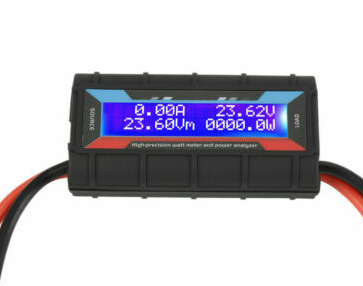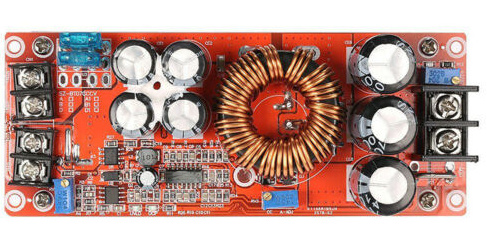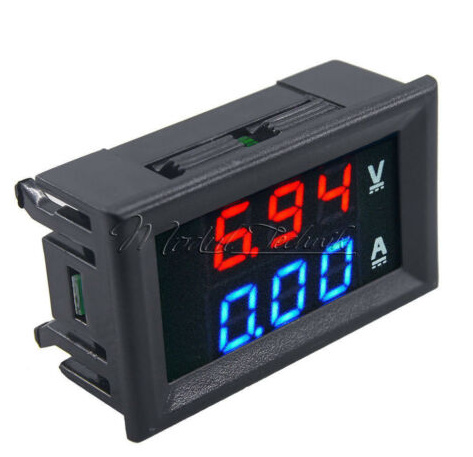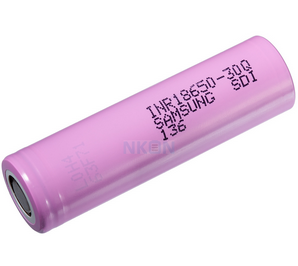@mynamesmatt Interesting… how do you protect your portable charger from draining your batteries down too low ?
Also since you can boost the voltage I guess you could use a 12S1P to charge a 12S4P without any issues ?
@mynamesmatt Interesting… how do you protect your portable charger from draining your batteries down too low ?
Also since you can boost the voltage I guess you could use a 12S1P to charge a 12S4P without any issues ?
I am thinking of using this DC DC Step Up converter and then have a Input Voltmeter and an output Voltmeter with included Amp Meter.
I am not sure how to set the Low Battery protection - but this might help my question from before how to make sure you don’t drain the battery to a too low voltage.
Do you charge your portable battery pack with a BMS or just directly without (I plan on just charging it directly because it’s just a portable pack…)
I’d look at a step up instead of a step down it’s easy a to deal with the battery output decreasing in voltage as the pack you charging increased if you always have a lower voltage in the portable pack. As it always be stepping the voltage up. no step down then up change over to deal with.
Protect the portable battery with a discharge BMS in case you forget to unplug it.
My consern would be how dose the board BMS deal with charge and discharge simultaneously?
I am not sure if I want to go the route of an extra BMS. I might just use a Input Volt and Output Voltmeter to monitor the charging process. Also the other Step Up Converter has some kind of a low voltage protection…
So I will use that I think.
Just not sure yet if I should go with a 12S1P or 12S2P.
I think charging the portable pack without a BMS/Balancer won’t ruin much to be honest…
essentially yes. so as the module i linked is a step up, it’ll take the voltage from your range extending pack, and pull the necessary current from it to get the 50.4v out at (say 4a). so once your extender pack gets to like 45v, it’ll just pull more current from the pack to push the set current and voltage.
Also, there is a low voltage protection in built, but it’s a bit sketchy. so on the packs i have a cheap charge/discharge bms (over 30a isn’t really necessary) which i have a charge port hooked too and the output with an antispark. so i just open the box, plug in and I’m on my way.
if you just wanna balance charge, you can use a hobby charger, and get a 100v volt and ammeter and just keep an eye on it so the voltage doesn’t get too low (have it sitting between the boost converter and battery so you can see what’s being pulled from the pack)
My other extender I’ve made is a bit more complicated. I’ve used a 6s 12ah pack, with a supower 30a bms, hooked up to the boost converter, also hooked up to a capacity meter, and then the charger is a Step DOWN converter to take 42v and pull it down to 25.2v.
I would use a step up converter. The onewheel guys use this solar charge controller as an adjustable stepup converter. I have the same setup and it works great, even same voltage to same voltage since as the booster pack goes lower than the main pack, it can still crank power into your main pack while controlling the amps. https://onewheel.wiki/Charging_on-the-go
This would let you use anything as input voltage, for example I use a 12v battery from my small solar setup to charge my onewheel at 58v.
in my experience throwing a 3v and 4v 30Q cell together in parallel maybe increased the heat by 5 degrees F. MAYBE you could just throw the two in parallel when the one on the board is dying. 
I did the math based on ohm’s law and assuming this 30Q resistance and 10s3p
here’s how MY math goes and maybe someone can correct it:
first finding the resistance of the 3 cells in parallel would be 1/.034 + 1/.034 + 1/.034…and keeping it simple lets call it 1/.1, so answer being .01 for each p group and then add 10 in series getting to .1ohms for the battery. and you have to take into account the other battery’s resistance as well I think so would be .2ohms total for both batteries the voltage would be applied to.
assuming a 5v difference between the old battery and new, so 35v for the dead and 40 for the new ohm’s law says it would be a 25 amp charge current. for (3) 30Q cells the stated max charge current for 3p would be 12amps, but that’s a conservative number assuming any state of charge and at lowest states of charge you can do more. Id do it and see at what state of charge the battery starts to heat up knowing the charge rate will drop quickly as the cells get closer in voltage. a bms would likely be an obstacle
So I ordered the parts now… I will do the following:
So I wonder if I could charge my Board while using it - I never actually tried using the board while charging the BMS Port - but it should work.
How much charge current do you use ? I think around 5A should be sufficient and safe.
Some of the items:





Also this portable battery pack might be useful for any kind of “on the go” electronics projects and I can use it for all of my boards - so this investment for sure might be the best solution for my “lightweight” boards to add some extra range when needed.
Also I think I will go for the LG M36 Batteries… they have more capacity and since discharge current is not important I can get 600mAh more for the same price…
LG M36 are 3600 mAh and Samsung 30Q are 3000 mAh
The Samsung 35E might also do the job…
So yeah thats what I will do.
Also probably due to the very constant discharge of the cells I could imagine that they should also last quite a bit longer. Also you could get away with discharging them to a lower voltage without ruining them.
This means that my 12S2P Portable pack with 20% more capacity (3600mAh compared to 3000mAh) and the ability to discharge to a lower voltage should basically give me at least a 50%+ overall boost to my 12S4P pack (considering also the efficiency of the step up converter).
So this doesn’t sound bad at all. And now I ordered all the parts.
But as many of you know - especially the chinese parts will take a while but since the batterys and the converter should come first that’s at least a good way to start the project process earlier.
@mynamesmatt Does the Step up Converter get quite hot ?
yeah dude this is pretty much exactly what I’ve done. it’ll work very well. i find it’s good for when you wanna do a longer ride, yet when you do a shorter ride you just unplug it and you’re right. think of it as a power bank for your esk8 (and yes you can charge while riding). and yeah 5a is a pretty good sweet spot. Also you wanna consider the Max current draw. so once the 12s pack is at 3.2v/cell, the pack draw will be just under 7a (incl losses).
without sufficient cooling and high current (7a+), yes. with air flow over the big mf heatsink, you’re pretty right. gets a bit warm but it’s ok.
try design your box to mount the step up on the corner mounting holes so that the heat sink sticks out, then seal the edges ya get me?
what board or bms?
also with this, i find there’s still a minor pop if you push it in too hard. a standard 24v 20a switch works fine really. it’s what I’ve got on my 6s pack box
Sure that was my plan - I was only thinking if I also have to add some cooling fans but this would have increased the size… So I guess I will try without fans just with the exposed heatsink.
Decided to use this to turn off and on

Should do the job
you won’t need fans no way. I’ve pumped 9a through one of these with no fans and it got pretty warm but was fine. at 5a you don’t need a fan no no no 
I’m pretty sure step up converters don’t do well stepping up to such close voltage differences-, like 12S to 12S charge voltage.
Is this what you said you were doing?
I’d recommend 8S, maybe 10S as supply so that it can effectively step up voltage to 12S. Everything else sounds great to me.
nah it does it fine. it essentially acts as a pasthrough at first, then as the voltage goes down, more current is pulled to get re desired voltage
I think thats the beauty of a switching converter… there is no real “deadzone” or “dropout limit”. Depending on the efficiency you might only lose some % on the output side.
So I also think it should do fine
Two first parts already arrived…
The Step-Up Converter and the Wattmeter.
I was able to regulate to a stable 50,4V even with my lab supply ranging from 8-17V for the first test run… seems very stable.
As soon as I get my battery I can set the current limit and then there is only the BMS and the case missing…